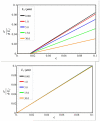Determining the contribution of glycosaminoglycans to tendon mechanical properties with a modified shear-lag model
- PMID: 23932185
- PMCID: PMC4182484
- DOI: 10.1016/j.jbiomech.2013.07.008
Determining the contribution of glycosaminoglycans to tendon mechanical properties with a modified shear-lag model
Abstract
Tendon has a complex hierarchical structure composed of both a collagenous and a non-collagenous matrix. Despite several studies that have aimed to elucidate the mechanism of load transfer between matrix components, the roles of glycosaminoglycans (GAGs) remain controversial. Thus, this study investigated the elastic properties of tendon using a modified shear-lag model that accounts for the structure and non-linear mechanical response of the GAGs. Unlike prior shear-lag models that are solved either in two dimensions or in axially symmetric geometries, we present a closed-form analytical model for three-dimensional periodic lattices of fibrils linked by GAGs. Using this approach, we show that the non-linear mechanical response of the GAGs leads to a distinct toe region in the stress-strain response of the tendon. The critical strain of the toe region is shown to decrease inversely with fibril length. Furthermore, we identify a characteristic length scale, related to microstructural parameters (e.g. GAG spacing, stiffness, and geometry) over which load is transferred from the GAGs to the fibrils. We show that when the fibril lengths are significantly larger than this length scale, the mechanical properties of the tendon are relatively insensitive to deletion of GAGs. Our results provide a physical explanation for the insensitivity for the mechanical response of tendon to the deletion of GAGs in mature tendons, underscore the importance of fibril length in determining the elastic properties of the tendon, and are in excellent agreement with computationally intensive simulations.
Keywords: Decorin; Extracellular matrix; Fibril length; Modeling; Proteoglycan.
Copyright © 2013 Elsevier Ltd. All rights reserved.
Figures








References
-
- Birk DE, Nurminskaya MV, Zycband EI. Collagen fibrillogenesis in situ: fibril segments undergo post-depositional modifications resulting in linear and lateral growth during matrix development. Dev Dyn. 1995;202:229–243. - PubMed
-
- Chen B, Wu PD, Gao H. A characteristic length for stress transfer in the nanostructure of biological composites. Composites Science and Technology. 2009;69:1160–1164.
-
- Cox H. The elasticity and strength of paper and other fibrous materials. British journal of applied physics. 1952;3:72–79.
Publication types
MeSH terms
Substances
Grants and funding
LinkOut - more resources
Full Text Sources
Other Literature Sources

